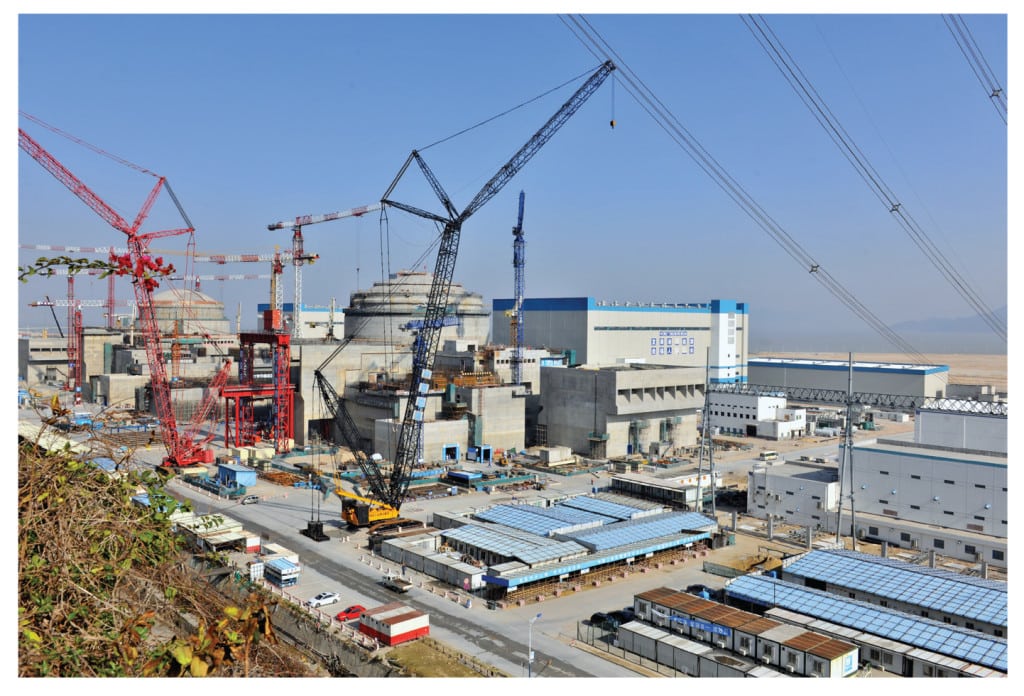China's Nuclear Expansion Mired in Overcapacity
China has brought 24 of its 36 operating nuclear reactors online at a breakneck pace since 2010, but there are signs it may roll out future plants that are still under construction more slowly, owing in part to a power capacity glut that shows no sign of relenting until at least 2020.
The country wants to install 58 GW of nuclear capacity by 2020, compared to the current 32.6 GW it has installed as of March 2017. Of the 23 GW (from 21 reactors) that is under construction, only six reactors are imported. These include four AP1000 reactors designed by Westinghouse and two EPRs developed by AREVA.
All six are facing delays. China General Nuclear Power, a subsidiary of China General Nuclear, in February told investors that after conducting a “comprehensive evaluation” of the engineering and construction plan and relevant risk, it opted to postpone the start of two EPRs at Taishan (Figure 2) by six months. Now, Taishan 1 is scheduled to start in the second half of 2017 and Taishan 2 in the first half of 2018. The reactors were originally anticipated to come online in 2009 and 2012, respectively.
Westinghouse’s construction of four AP1000 reactors in China, two each at Sanmen in Zhejiang province and Haiyang in Shandong, are reportedly nearing completion, though they too have been beset by delays ranging from three to four years, mostly owing to design changes. While construction kicked off at Sanmen Unit 1 in April 2009, and in September 2009 at Haiyang, all four reactors are slated to be operational by the end of this year.
But while those delays are technical, industry observers note that the slowdown in electricity demand has left China with a huge power capacity surplus that has forced some nuclear plants to compete with cheap coal and a flood of renewables. In October 2016, for example, Chinadialogue reported that the Hongyanhe 3 unit in Liaoning operated for only 987 hours in the first quarter of 2016 (at 45% availability), while reactors in Fujian and Hainan were shut down temporarily. POWER was unable to confirm the report.
According to a November 2016 IHS Energy report, China’s power companies put online 149 GW of new capacity, of all fuel types, in 2015 alone—a number representing about 40% of total global capacity additions—even though the country’s electricity demand growth fell to only 0.5%, the slowest since 1998. IHS Energy also predicted in the report that another 110 GW of new plants would come online in 2016, a figure that factored in project cancellations and delays. Looking forward, the report suggests that power demand may be 16.7% higher in 2020 compared to 2015, but that total generation capacity will likely surge even more, between 22% and 30%. “As a result, the system reserve margin will still be higher in 2020 than in 2015,” the information and analytics company said.
“The divergence in power demand between China’s domestic sector and heavy industries will become even more pronounced as the country continues its pivot toward a more service-led economy,” said Xizhou Zhou, senior director at IHS Energy. “This means China’s power consumption overall is going to shift into the slow-moving lane for several more years to come.”
The capacity glut has already affected China’s coal power sector. In part to stem overcapacity, China’s National Energy Administration this January ordered the cessation or postponement of 104 coal-fired power projects in 13 provinces—a combined 120 GW. About 54 GW of that capacity was reportedly under construction.
IHS Energy notes that because China’s Renewable Energy Law mandates that all renewables “must dispatch” to the grid, and additions of wind and solar projects have been rapid, other fuel sources have been suffering. For nuclear and hydro especially, average utilization hours have been dropping for the past two years.
The only fuel type that may see an increase in capacity factor is natural gas, IHS Energy predicted. This is likely due to anti-smog policies along coastal provinces. “As coal is restricted in these areas, gas is increasingly been used in combined heat and power plants to provide not just electricity but also heating and steam for municipal and industrial customers,” it said.
